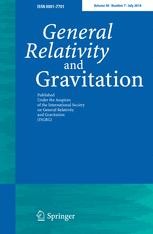GRG Editor's Choice: 2-vertex Lorentzian spin foam amplitudes for dipole transitions
 Sarno, G., Speziale, S. & Stagno, G.V., 2-vertex Lorentzian spin foam amplitudes for dipole transitions, Gen Relativ Gravit (2018) 50: 43. https://doi.org/10.1007/s10714-018-2360-x
Sarno, G., Speziale, S. & Stagno, G.V., 2-vertex Lorentzian spin foam amplitudes for dipole transitions, Gen Relativ Gravit (2018) 50: 43. https://doi.org/10.1007/s10714-018-2360-x
Editor's Choice (Research Article)
First Online: 23 March 2018
"This paper is one of the most important ones on spin-foams in the last few years. It is furthermore written in such a way that it is optimal for both experts and non-experts in spin-foams. This article addresses a number of the core open questions in spin-foams which have been rarely if at all addressed in the literature till now. The authors do this by making use of new techniques for evaluating spin-foam amplitudes numerically, applied to a simple, but sufficient, choice of boundary graph. It yields preliminary important results and insights on these issues. It furthermore provides a review of the new methods used, a review which will no doubt be invaluable for the research community."
Abstract:
We compute transition amplitudes between two spin networks with dipole graphs, using the Lorentzian EPRL model with up to two (non-simplicial) vertices. We find power-law decreasing amplitudes in the large spin limit, decreasing faster as the complexity of the foam increases. There are no oscillations nor asymptotic Regge actions at the order considered, nonetheless the amplitudes still induce non-trivial correlations. Spin correlations between the two dipoles appear only when one internal face is present in the foam. We compute them within a mini-superspace description, finding positive correlations, decreasing in value with the Immirzi parameter. The paper also provides an explicit guide to computing Lorentzian amplitudes using the factorisation property of SL(2,C) Clebsch–Gordan coefficients in terms of SU(2) ones. We discuss some of the difficulties of non-simplicial foams, and provide a specific criterion to partially limit the proliferation of diagrams. We systematically compare the results with the simplified EPRLs model, much faster to evaluate, to learn evidence on when it provides reliable approximations of the full amplitudes. Finally, we comment on implications of our results for the physics of non-simplicial spin foams and their resummation.
The authors:
Gabriele V. Stagno (from Sapienza Università di Roma) and Giorgio Sarno are working together with Simone Speziale in the Quantum Gravity group of the Centre de Physique Théorique, Marseille, France.
GRG Editor's Choice:
In each volume of GRG, a few papers are marked as “Editor’s Choice”. The primary criteria is original, high quality research that is of wide interest within the community.
